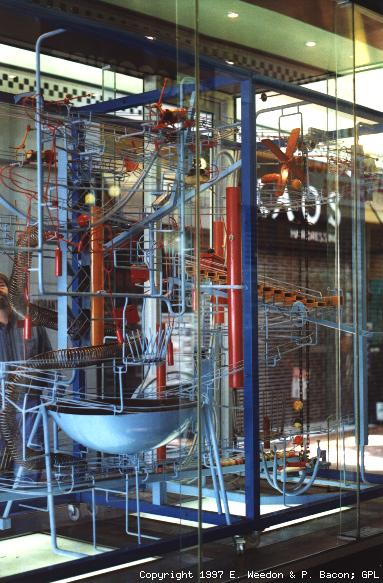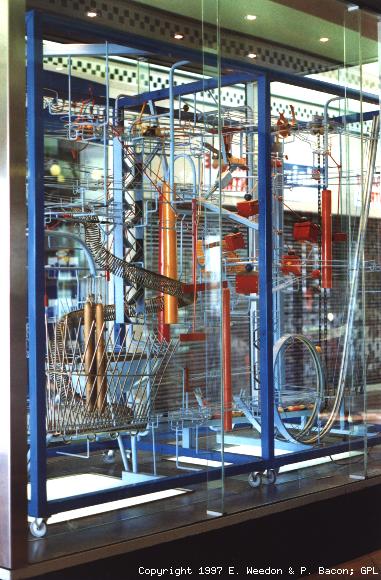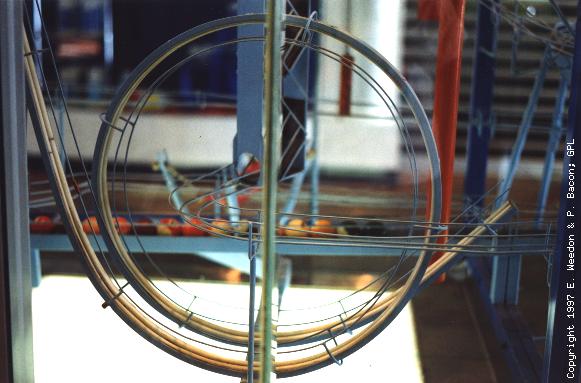
The Rolling Ball Web
An Online Compendium of
Rolling Ball Sculptures, Clocks, Etc.
By David M. MacMillan et. al.
Eugenia Weedon took the following pictures in 1997 and has been kind enough to allow their inclusion here. They show Rhoads' Global Circus as it stands in the Northland Shopping Mall in the outskirts of Melbourne, Australia. Note that this location is different than that reported in Rhoads' 1996 catalog.
Note: Some web browsers do not display images with full fidelity. For best image quality, save these images to temporary files and view them with an offline image viewing program. Please note that even when saved to files the licensing terms and the disclaimers stated in the Legal Matters section of this document still apply to these images.
(3 photos, approximately 157 kilobytes total)



Global Circus, a ball run sculpture by George Rhoads, is located in a shopping center in the outskirts of Melbourne, Australia. First made in 1985, the piece was refurbished for the 1988 World Expo, held in Brisbane, Australia, then purchased by the Gandel Group, a company that owns the Northland Shopping Mall, where the piece currently resides.
The sculpture, measuring 7'x10'x4', is enclosed in a huge glass case that sits just inside one of the entrances to the mall. A nameplate on the sculpture gives the artist's name, the name of the piece, and the date the sculpture was exhibited in Brisbane.
The balls that traverse the various paths and byways of the piece are regular billiard balls -- we counted 28 in all. They are carried to the top of the sculpture by a motor-driven chain that acts much like a ski lift. The chain itself is somewhat larger than a regular bike chain and is equipped with 16 metal brackets in which the balls sit while making their leisurely assent. The brackets are unevenly spaced along the chain, thereby lending randomness and unpredictability to the overall drama.
As each ball reaches the top of the chain, it rolls out onto a short segment of track that feeds into a slowly revolving metal plate or "distributor" designed to shunt the ball onto one of five main offshoots. A small electric motor turns the plate, which is, incidentally, the only motorized part of the entire piece other than the chain lift itself.
As each ball comes off the distributor and onto one of the five main branches, it begins a descent that may open or close various gates through which it passes. This in turn will affect the path and direction of subsequent balls, thereby introducing further variations into the piece. Some balls reach the bottom quite rapidly, while others take a minute or longer.
The paths themselves are quite varied. One, for instance, causes the ball to pass through a series of four levers. Each is fitted with a basket at one end and a ball (somewhat smaller than the billiard balls) at the other. When the lever is at rest the basket is uppermost, while the small ball sits on a hollow wooden block. As the billiard ball rolls into the first basket, its weight lowers that end of the lever. The billiard ball falls out as the lever reaches the bottom of its swing, the lever flips back to its original position, and the small ball at the lever's end strikes the wood block with a resounding "chock." The billiard ball passes through the whole series of levers in seconds, and the resulting "music" is quite pleasant.
Another path fed by the distributor at the top takes the ball along a high track that leads to an "elevator" of sorts, weighted at the far end with a metal pipe. The elevator and its pipe counterweight are connected by a long cord that turns a set of orange-colored blades located in the middle. The billiard ball descends slowly in its elevator cage, then at the bottom is deposited onto a lower track. This is one of the quieter entertainments in the sculpture and serves as contrast to some of the more dramatic segments.
Among these are a couple that strongly suggest trapeze artists. In one, the ball is released in mid-air, then plummets two or three feet onto a small wooden block. The block is angled precisely so as to bounce the ball trampoline-style several feet to a basket-like trap. In yet another death-defying leap, a ball is sent careening down an almost sheer drop and into a loop-the-loop structure. The ball exits with considerable velocity--enough so as to send it several feet through the air into yet another basket, and then on to the final portion of the track.
Two additional segments act rather like variations on a theme. In the first segment, located near the top of the piece, a ball is fed into a U-shaped track. Entering the track at one end, the ball rolls down to the bottom of the U, then up the other side, then falls back down again. It repeats this motion until it loses momentum and comes to rest. (In one case, we counted 72 rolls back and forth.) Once the ball stops its back and forth motion, it is then free to respond to the slight tilt of the U and to roll through an exit onto a connecting track. From here it resumes its downward progress. In the second segment, a ball is fed into the top of a large wok-like bowl with a small hole in the bottom center. Momentum causes the ball to circle the bowl near the rim at first; then, as it begins to lose speed, the ball comes closer and closer to the hole. Eventually, it all but stops and is able to pass through the hole onto the next track below.
Most of the pathways are equipped with sound effects. In addition to the series of levers and wooden blocks, and the trampoline-like wooden block, there is a mushroom-shaped metal chime near the top that is struck by some of the balls as they begin their descent. There is also an assemblage of six hanging wooden rods (three small and three rather large) that produce a toneful clatter as they are struck by balls shooting out of the loop-the-loop structure described above. Adding to the musical ensemble are several metal tubes of varying lengths and diameters that block sections of track and ring out as passing balls strike them. Finally, there is a dramatic xylophone stairway consisting of 13 steps or keys, and a 14th and final tone-producing key that deflects the ball onto an exit track. The riff produced by balls descending the stairway is definitely one of the musical highlights of the piece.
If the loop-the-loop leap qualifies as the most daring event in the sculpture, then a suite of delicately weighted armatures mounted at one corner of the piece gets our vote as the most graceful and elegant. Each armature is fitted with a basket at one end and a counterweight at the other. As the ball falls into the topmost basket, its momentum momentarily overcomes the inertia of the counterweight and carries the armature through an almost 180-degree swing. The armature then swings back up, depositing the ball onto a short length of track that leads to the second armature. The ball traverses four such armatures in rapid succession, setting them all in motion as it descends. The overall effect -- reminiscent of branches swaying in the breeze -- is quite lovely. In fact, we could easily imagine a piece composed entirely of a larger array of such armatures (perhaps of varying colors, lengths, and rhythms).
Another, somewhat similar structure on the other side of the piece involves but a single basket/armature device. However, this device in turn sets in motion three pendulum-like armatures, again suggesting waving branches.
Two other portions of the piece deserve mention. One of these -- a "dumper" (Rhoads' own term)--halts the balls altogether. Not until three or four balls have stacked up here does the combined weight pitch the basket forward, emptying the balls out onto a lower track. (As the armature returns to its original position, it opens a gate so that succeeding balls arriving at this point will be shunted onto another track.) In yet another place located near the top of the sculpture, balls must pass through a small disk that swivels back and forth on the vertical plane between two settings. As the balls pass through this gate or switch, they are shunted alternately to the left or right.
Bright colors complement the playfulness of the piece. The overall rectangular metal frame is an electric blue, while the track and many of the supporting rods are a lighter sky blue. The remainder of the piece is painted tomato red, mustard yellow, orange, or steel blue.
We found the work absolutely spell-binding and stayed there for close to an hour, following the progress of various balls in their descent, taking photos, and trying to see just how everything worked. We especially liked the variety built into the piece. If it were possible to imagine the various segments as personalities, we might say that some were extraverts--the two mid-air leaps, for instance--while others were decidedly introverts. Additional variety came from the sounds that the piece made. Mercifully, the sculpture does not produce a relentless series of musical tones; to the contrary, there are enough silent stretches that when the sounds come, they are still able to surprise and delight. There is considerable variety as well in terms of just how visually busy the whole piece is. At times there is so much going on that it would be virtually impossible to follow the progress of all the balls at once; at other moments only a few balls can be seen making their descent; and once during our stay, we noticed that all 28 balls had reached the bottom and were either making their ascent to the top or waiting sedately for the next available "lift."
If we had Rhoads's ear and could make suggestions, the only one might be to retune the traps, gates, and releases so that balls would activate a couple of the segments more often. The ones with the swinging armatures or pendulums in particular seemed to get short shrift.
Taking still photos of the piece was a bit of a challenge, for several reasons.
First and foremost, perhaps, is the (obvious) fact that any piece of kinetic sculpture is best viewed in motion--i.e., videotaping would have captured both the spirit and the actual structure of the piece far more faithfully than a 35mm SLR camera.
Second, although afternoon light from the nearby exit turned out to be adequate, it cast reflections on the glass case, especially the side nearest the door, making it difficult to take pictures from that angle. (Unfortunately, our camera was not equipped with a polarizing filter to cut down on glare.) Photographing the sculpture in its entirety from either side was impossible, due to the narrowness of the hallway. I'm not even sure a wide-angle lens would have solved the problem.
Third and last, the piece itself is a visual jumble by any standard--and if this is true in three dimensions, it is even more so in two. Our camera was not fitted with a close-up or zoom lens, though it did occur to us that using such a lens in tandem with a flash attachment, while keeping depth of field as shallow as possible, might allow a photographer more skilled than either of us to isolate portions of the work while throwing background clutter out of focus. The only other alternative for getting clutter-free photos of the various segments would be to mask the background with sheets, dropcloths, or the like so as to photograph each segment one at a time in isolation from the rest.
Finally, we regretted that the sculptor's name was misspelled on the nameplate ("Rhodes," rather than "Rhoads"), that there was no bio or other information about the artist, and that there was no notice posted on or near the piece to refer passers-by either to the ball run web page or to the web site for the Tech Museum in San Jose, which contains much information about Rhoads, along with a number of photos. In fact, I am thinking of contacting the folks who own the mall to bring these matters to their attention.
Incidentally, for anyone in or near Melbourne who would like to visit the sculpture at the Northland Shopping Mall, approximately a half hour north of downtown Melbourne, we suggest you park close to the K-mart and Coles stores and enter there. You can't miss it. And you shouldn't!
With the exception of any material noted as being in the public domain, the text, images, and encoding of this document are copyright © 1997-1998 by Peter Bacon, Eugenia Weedon and David M. MacMillan.
This document is licensed for private, noncommercial, nonprofit viewing by individuals on the World Wide Web. Any other use or copying, including but not limited to republication in printed or electronic media, modification or the creation of derivative works, and any use for profit, is prohibited.
This writing is distributed in the hope that it will be useful, but "as-is," without any warranty of any kind, expressed or implied; without even the implied warranty of merchantability or fitness for a particular purpose.
In no event will the author(s) or editor(s) of this document be liable to you or to any other party for damages, including any general, special, incidental or consequential damages arising out of your use of or inability to use this document or the information contained in it, even if you have been advised of the possibility of such damages.
In no event will the author(s) or editor(s) of this document be liable to you or to any other party for any injury, death, disfigurement, or other personal damage arising out of your use of or inability to use this document or the information contained in it, even if you have been advised of the possibility of such injury, death, disfigurement, or other personal damage.
All trademarks or registered trademarks used in this document are the properties of their respective owners and (with the possible exception of any marks owned by the author(s) or editor(s) of this document) are used here for purposes of identification only. A trademark catalog page lists the marks known to be used on these web pages. Please e-mail dmm@lemur.com if you believe that the recognition of a trademark has been overlooked.
Version 1.6, 1998/06/18. Feedback to dmm@lemur.com
Go to the: